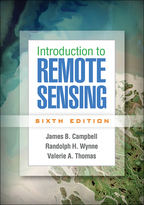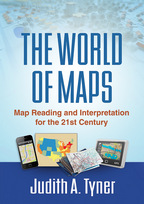Introduction to Remote Sensing
Sixth Edition
James B. Campbell, Randolph H. Wynne, and Valerie A. Thomas
Hardcovere-bookprint + e-book
Hardcover
orderAugust 23, 2022
ISBN 9781462549405
Price: $108.00 634 Pages
Size: 7" x 10"
Full-Color Throughout
“An outstanding guide….This book is an excellent text for an introductory remote sensing course. It is also an appropriate addition to anyone's library who is trying hard to keep up with all the changes in the remote sensing technology. This book has a valued place on my bookshelf.”

—Photogrammetric Engineering and Remote Sensing (on the fifth edition)
“The text provides comprehensive coverage of principal topics and serves as a framework for organizing the vast amount of remote sensing information available on the web. Featuring case studies and review questions, the book’s chapters are carefully designed as independent units that instructors can select from as needed for their courses.”

—Lunar and Planetary Information Bulletin (on the fifth edition)
“This outstanding text provides a clear and comprehensive introduction to the fundamentals of a rapidly developing, interdisciplinary field. The book has helped prepare a generation of remote sensing scientists, and remains relevant and important today. The sixth edition's discussions of unmanned aerial systems and small satellites are timely; this edition also has a greater emphasis on digital imagery and its processing. Suitable for undergraduate and graduate students, the text contains sufficient content for one or more remote sensing courses. It has a focus on land remote sensing and develops natural, urban, ecological, hydrological, and other land-cover/land-use applications very well.”

—J. B. Sharma, PhD, Professor Emeritus and Eminent Scholar, Department of Physics and Astronomy, University of North Georgia
“The sixth edition of this classic text covers the fundamental principles of remote sensing as well as applications. A particular strength of the text is its coverage of the historical development of the field, from the first aerial photographs and Landsat satellites to today's small satellites, unmanned aircraft, and mobile sensors. The development of new sensor technologies, such as different types of lidar, is well described. Each chapter ends with lists of learning resources on the Internet, review questions, and references. I recommend this sixth edition as both a core text for undergraduate and graduate courses and a useful reference for remote sensing professionals.”

—Håkan Olsson, PhD, Professor Emeritus of Forest Remote Sensing, Swedish University of Agricultural Sciences
“Introduction to Remote Sensing has an excellent reputation as one of the preeminent textbooks for undergraduate courses in remote sensing and image processing. As a university instructor, I first used this text in 1996. Twenty-five years later, the sixth edition has evolved to keep pace with a highly technical discipline. The book captures how the field has changed in terms of remote sensing technologies, image processing techniques, and software packages. We are entering an era where new sensing technologies and publicly available high-resolution satellite data are readily accessible and available for short- and long-term studies; the opportunities provided by these changes are described in detail in the sixth edition. I thank the authors for their diligence in providing up-to-date information in this dynamic area. Congratulations!”

—Paul Treitz, PhD, Department of Geography and Planning, Queen’s University, Ontario, Canada
“I have found prior editions to cover all the topics I want my students to learn in Introductory Remote Sensing. In the sixth edition, the updated chapter on land observation satellites provides a nice overview of optical systems currently in operation, as well as history of the longer programs. The section on satellite systems in Chapter 3 provides some good background on the parts of satellites and their characteristics like orbit, footprints, and constellations. Other updates include a shorter chapter on the history of remote sensing, a new chapter on forestry, and some reorganization of the chapters. I look forward to adopting the sixth edition!”

—Mary C. Henry, PhD, Department of Geography, Miami University
—Photogrammetric Engineering and Remote Sensing (on the fifth edition)
“The text provides comprehensive coverage of principal topics and serves as a framework for organizing the vast amount of remote sensing information available on the web. Featuring case studies and review questions, the book’s chapters are carefully designed as independent units that instructors can select from as needed for their courses.”
—Lunar and Planetary Information Bulletin (on the fifth edition)
“This outstanding text provides a clear and comprehensive introduction to the fundamentals of a rapidly developing, interdisciplinary field. The book has helped prepare a generation of remote sensing scientists, and remains relevant and important today. The sixth edition's discussions of unmanned aerial systems and small satellites are timely; this edition also has a greater emphasis on digital imagery and its processing. Suitable for undergraduate and graduate students, the text contains sufficient content for one or more remote sensing courses. It has a focus on land remote sensing and develops natural, urban, ecological, hydrological, and other land-cover/land-use applications very well.”
—J. B. Sharma, PhD, Professor Emeritus and Eminent Scholar, Department of Physics and Astronomy, University of North Georgia
“The sixth edition of this classic text covers the fundamental principles of remote sensing as well as applications. A particular strength of the text is its coverage of the historical development of the field, from the first aerial photographs and Landsat satellites to today's small satellites, unmanned aircraft, and mobile sensors. The development of new sensor technologies, such as different types of lidar, is well described. Each chapter ends with lists of learning resources on the Internet, review questions, and references. I recommend this sixth edition as both a core text for undergraduate and graduate courses and a useful reference for remote sensing professionals.”
—Håkan Olsson, PhD, Professor Emeritus of Forest Remote Sensing, Swedish University of Agricultural Sciences
“Introduction to Remote Sensing has an excellent reputation as one of the preeminent textbooks for undergraduate courses in remote sensing and image processing. As a university instructor, I first used this text in 1996. Twenty-five years later, the sixth edition has evolved to keep pace with a highly technical discipline. The book captures how the field has changed in terms of remote sensing technologies, image processing techniques, and software packages. We are entering an era where new sensing technologies and publicly available high-resolution satellite data are readily accessible and available for short- and long-term studies; the opportunities provided by these changes are described in detail in the sixth edition. I thank the authors for their diligence in providing up-to-date information in this dynamic area. Congratulations!”
—Paul Treitz, PhD, Department of Geography and Planning, Queen’s University, Ontario, Canada
“I have found prior editions to cover all the topics I want my students to learn in Introductory Remote Sensing. In the sixth edition, the updated chapter on land observation satellites provides a nice overview of optical systems currently in operation, as well as history of the longer programs. The section on satellite systems in Chapter 3 provides some good background on the parts of satellites and their characteristics like orbit, footprints, and constellations. Other updates include a shorter chapter on the history of remote sensing, a new chapter on forestry, and some reorganization of the chapters. I look forward to adopting the sixth edition!”
—Mary C. Henry, PhD, Department of Geography, Miami University




